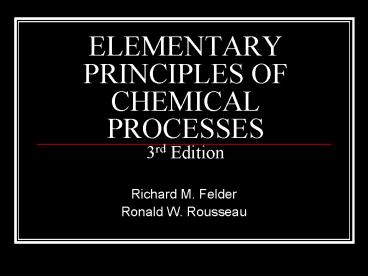ELEMENTARY PRINCIPLES OF CHEMICAL PROCESSES 3rd Edition - PowerPoint PPT Presentation
1 / 23
Title:
ELEMENTARY PRINCIPLES OF CHEMICAL PROCESSES 3rd Edition
Description:
... does 2 ft3 of water weigh at sea level and in Colorado where the altitude is ... A force of 355 poundals is exerted on a 25.0-slug object. ... – PowerPoint PPT presentation
Number of Views:1829
Avg rating:3.0/5.0
Title: ELEMENTARY PRINCIPLES OF CHEMICAL PROCESSES 3rd Edition
1
ELEMENTARY PRINCIPLES OF CHEMICAL PROCESSES3rd
Edition
- Richard M. Felder
- Ronald W. Rousseau
2
CHAPTER 2
- INTRODUCTION TO ENGINEERING CALCULATIONS
3
UNITS AND DIMENSIONS
- All measured property has a value and a unit
- A dimension is a property that can be measured,
or calculated by multiplying or dividing other
dimensions. - Measurable units are specific values of
dimensions that have been defined by convention,
custom, or law.
4
- Numerical values of two quantities may be added
or subtracted only if the units are the same - Numerical values and their corresponding units
may always be combined by multiplication or
division
5
SYSTEMS OF UNITS
- Base Units
- Multiple Units
- Derived Units
- SI system
- CGS System
- American Engineering System
6
BASE UNITS
7
Multiple Units
- Tera (T) 1012
- Giga (G) 109
- Mega (M) 10 6
- Kilo (k) 103
- Centi (c) 10-2
- Milli (m) 10-3
- Micro (µ) 10-6
- Nano (n) 10-9
8
CONVERSION OF UNITS
9
CONVERSION OF UNITS
- Conversion factors
- 1 cm 10 mm
- 10 mm 1 cm
- Convert 36 mg to grams.
10
Conversion the Chemical Engineer way!!
- Convert 1 cm/s2 to it equivalent in km/yr2 .
- The Gas Constant R 8.314 m3-Pa/mol K. What is
the value of R in lit-bar/mol K and cal/mol-K.
11
PROBLEM!!
- A supersonic aircraft consumes 5320 imperial
gallons of kerosene per hour of flight and flies
an average of 14 hours per day. It takes roughly
seven tons of crude oil to produce one ton of
kerosene. The density of kerosene is 0.965 g/cm3.
How many planes would it take to consume the
entire annual world production of 4.02109 metric
tons of crude oil?
12
FORCE AND WEIGHT
- Force mass acceleration
- Units Newton (SI) Dyne (CGS)
- Pound-force (FPS)
- 1 N 1 kg.m/s2
- 1 dyne 1 g.cm/s2
- 1lbf 32.174 lbm .ft/s2
13
More conversions
- What force would be required to accelerate a mass
of 4 lbm at a rate of 9 ft/s2 ? - 1 kg.m/s2 32.174 lbm.ft/s2
- gc
- 1 N 1 lbf
14
DO NOT CONFUSE gc WITH g
- g acceleration due to gravity
- 9.8066 m/s2
- 980.66 cm/s2
- 32.174 ft/s2
- Water has a density of 62.4 lbm/ft3 . How much
does 2 ft3 of water weigh at sea level and in
Colorado where the altitude is 5374 ft and the
gravitational acceleration is 32.139 ft/s2 ?
15
PROBLEM 2.14
- A poundal is the force required to accelerate a
mass of 1 lbm at a rate of 1 ft/s2 and a slug is
the mass of an object that will accelerate at a
rate of 1 ft/s2 when subjected to a force of 1
lbf. - Calculate the mass in slugs and the weight in
poundals of a 175 lbm man on (i) earth and (ii)
on the moon where the acceleration of gravity is
one-sixth of its value on earth - A force of 355 poundals is exerted on a 25.0-slug
object. At what rate (m/s2) does the object
accelerate?
16
PROCESS DATA REPRESENTATION AND ANALYSIS
- Interpolation or extrapolation can be done by
- Two point linear interpolation/ extrapolation
- Graphical interpolation / extrapolation
- Curve fitting
- Linear regression or method of least squares
17
SCIENTIFIC NOTATION, SIGNIFICANT FIGURES AND
PRECISION
- Significant figures of a number are the digits
from the first nonzero digit on the left to
either - the last digit on the right if there is a
decimal point or - the last nonzero digit of the number if there is
no decimal point
18
RULES
- When two or more quantities are combined by
multiplication and/or division, the number of
significant figures in the result should equal
the lowest number of significant figures of any
of the multiplicants or divisors - When two or more numbers are added and or
subtracted, the positions of the last significant
figures of each number relative to the decimal
point should be compared. Of these positions, the
one farthest to the left is the position of the
last permissible significant figure of the sum or
difference.
19
CHAPTER 3
- PROCESS AND PROCESS VARIABLES
20
MASS AND VOLUME
- Density mass per unit volume
- Kg/m3, g/cm3, lbm/ft3
- Specific Volume 1/density
- Specific Gravity ratio of density of a
substance to the density of a reference substance
at a specific condition (Units?)
21
- Calculate the density of mercury in lbm/ft3.
Specific gravity of mercury at 20C is 13.546.
Also calculate the volume in ft3 occupied by 215
kg mercury.
22
EFFECT OF TEMPERATURE
- Temperature variation may be in either direction.
- Perrys Chemical Engineers Handbook,
- pp. 2-128 to 2-131
23
FLOW RATE
- Mass flow rate
- Volumetric flow rate

